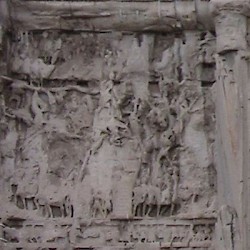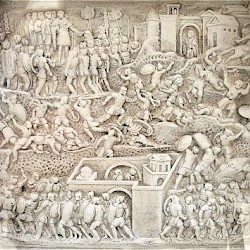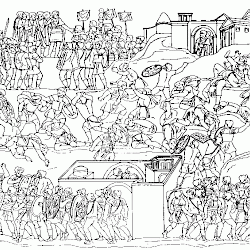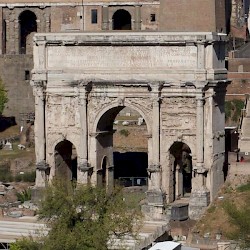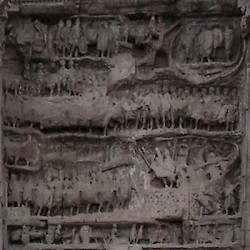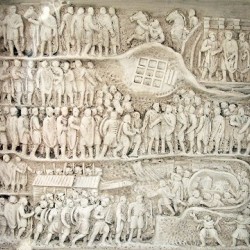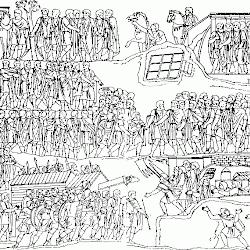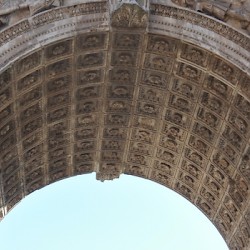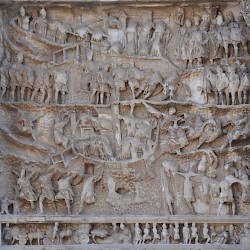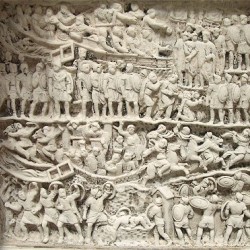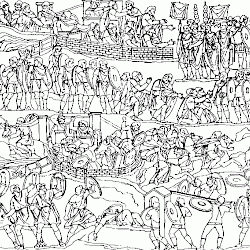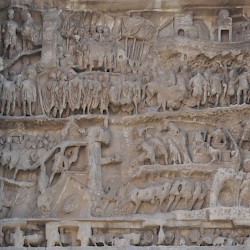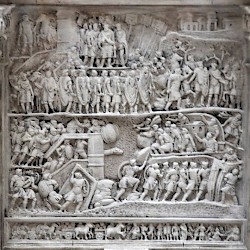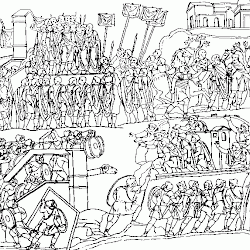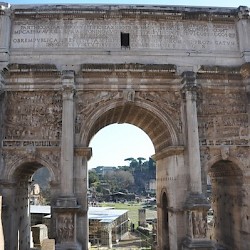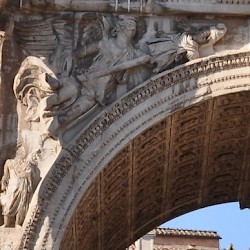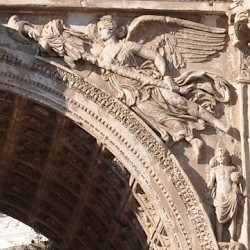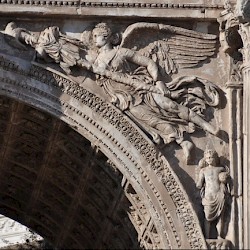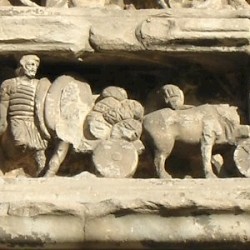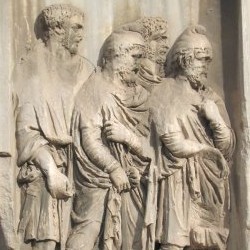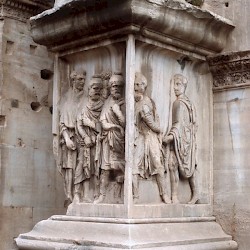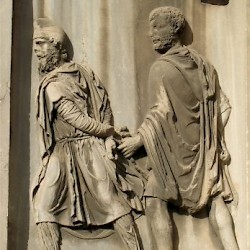Rome, Forum, Arch of Septimius Severus
Q162353Arch of Septimius Severus: honorific arch on the Forum Romanum.
No Triumph

The Arch of Septimius Severus is arguably the most impressive monument on the Forum Romanum. Although the statues on the top of the arch are now lost, the reliefs have lost their painting, and two reliefs are almost illegible, the monument as a whole is very well-preserved.
The emperor Septimius Severus came to power in 193. On 31 December 192, Commodus had been assassinated and succeeded by the old general Pertinax, who had in turn been lynched by soldiers on 28 March. The imperial guard had sold the monarchy to another general, Didius Julianus. On hearing the news, the conspirators who had put Pertinax on the throne, decided to act again. Severus, the governor of Pannonia, gained the support of the army of the Danube and marched on Rome. Julianus was executed on 1 June, and the Senate recognized Severus.

This was not the end of the matter, however. In the west, Clodius Albinus had been proclaimed emperor; in the east, Pescennius Niger. Severus acted swiftly. He secured his back by signing a treaty with Albinus, and attacked Pescennius, who was dethroned in April 194. The victor of the civil war still needed the prestige of a real victory in a foreign war, and therefore attacked the Parthian Empire, where king Vologases V had supported Pescennius Niger. As a reward for this foreign victory (in 195), the Senate awarded him a triumphal entry into the city and an arch, which is shown on this gold piece.
Severus politely declined the honor when he returned in 196. He would look like a victor in a civil war. The next year, he attacked his former ally Clodius Albinus, and returned to the east, where he continued the war with three new legions: I Parthica, II Parthica, and III Parthica. Now, he captured the Parthian capital Ctesiphon (198). Again, Severus received the honor of triumphal entry, but this time, he was forced to refuse because he suffered from gout.

The arch was built, nevertheless. It commemorated two Parthian wars and mentioned (in the inscription) the emperor and his two sons, Caracalla and Geta. When Caracalla had succeeded his father and had killed his brother, the name of the younger brother was erased.
The Monument

The monument is almost 21 meters high, has a width of more than 23 meters, and is made of Proconessian white marble from the Sea of Marmara, which was very much en vogue during the reign of Septimius Severus. The monument was built close to the Senate's meeting place, the Curia Julia. According to Herodian and Cassius Dio, Severus had dreamt that he had climbed the horse of Pertinax on this spot.note Therefore, the arch was erected over here. There was also an equestian statue.
The most important parts of the Arch of Septimius Severus are the four reliefs, which measure almost 4 x 5 meters and show scenes of the wars against the Parthian Empire. The sequence is indicated by four statues of the four seasons, which can be seen at the feet of the Victorias in the spandrels. Like the relief on the Column of Trajan, the four reliefs has to be read from bottom to top. The western façade, unfortunately, is very damaged, because it has always been exposed to the wind and a fire in the Middle Ages.
Relief 1 (Forum, left)
On the first relief, which is extremely damaged, we can see preparations for the first of the two wars, a battle scene, and the liberation of Rome's ally Nisibis in 195, which had been attacked by the Parthians when the Romans were involved in a civil war. An enemy leader flees to the right.
Relief 2 (Forum, right)
Because the right-hand side of the eastern face of the arch is damaged as well, we do are not completely certain what is shown. A possible hypothesis is that it shows the revolt of a Roman ally, Edessa, the capital of Osrhoene. The town is attacked with siege engines (bottom) and king Abgar VIII surrenders (central scene). In the upper register, we see how Septimius Severus announces the annexation of Osrhoene and Nisibis.
Relief 3 (Capitol, left)
Moving to the Capitol side, we get a better view of the reliefs, which show the second Parthian campaign (197-198). On the left-hand side, we see how the Romans attack Seleucia, an important city on the Tigris. The Parthian soldiers flee towards the left and right. The upper part shows how the citizens surrender.
Relief 4 (Capitol, right)
On the right-hand side of the side facing the Capitol, we see the last battle of the war: the siege and sack of Ctesiphon, the Parthian capital. A siege engine is employed (bottom left) and the city surrenders (right). In the upper register, we see how Septimius Severus declares that his oldest son Caracalla will be his co-ruler and that his younger son Geta will be crown prince.
This declaration of Ctesiphon was on 28 January 198, exactly hundred years after the accession of the emperor Trajan, who had been unable to defeat the Parthians and occupy Mesopotamia. Severus wanted everybody to remember that he had succeeded where Trajan had failed
Other sculpture
There are more reliefs on the arch of Septimius Severus: Victorias are flying in the spandrels, there four statues of the four seasons, and the pedestals are decorated with prisoners of war. Below the four main reliefs, we can see how the loot is being transported.
Another Arch of Septimius Severus was erected in Lepcis Magna.
Literature
- R. Brilliant, The Arch of Septimius Severus in the Roman Forum (1967)
- M. Lloyd, "The Arch of Septimius Severus in the Roman Forum: a Re-Consideration", in: American Journal of Ancient History ns. 117 (2013)
I have followed Brilliant's interpretation.
